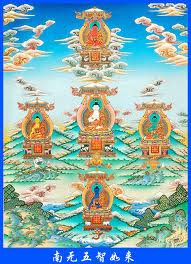Clarity & Intelligence
Often we talk a lot about the neuroses involved in each of the 5 Families. We need to remember our Buddha Nature though and learn to recognize the underlying intelligence and wisdom that is present in all aspects of our dealings with our world.
Therefore each of the 5 Families has a corresponding Wisdom which is just as available to us as the neuroses are. In fact, the Wisdom energy is hidden underneath all of those neuroses. Our neuroses are just a twisted and corrupted expression of our own wisdom. The words "tainted" or "impure" are often used to describe this.
Why are there 5 wisdoms? This is because the world that we live in is composed of Water, Earth, Fire, Wind, and Space. Within these elements are the natural laws and energy of the world. Our Body/Mind components also are reflections of these elements.
Our Body and Forms represent the cohesiveness and connecting aspect of the Water element. Our Feelings reinforce the solidity and texture of the Earth element. Our perceptions relate to the attraction and repulsion of the Fire element. Our Intentions and Will connect to the movement and action aspects of the Wind element. Finally, our Consciousness is our connection to the range and inclusiveness of the Space element.
If we express the energy of these elements naturally then they manifest as the 5 wisdoms of Intelligence, Equality, Investigation, Skillfulness, and Awareness. When we fight with, or grasp, or are overwhelmed by these energies, they lead to the many types of neuroses of which the main ones are Anger, Attachment, Longing, Jealousy, and Confusion.
The key is to learn to become knowledgeable, relaxed and skillful in handling these various energies and therefore learn to express them as Wisdoms, instead of Neuroses. In learning how to do this, we will start with the most external of these Wisdoms and gradually work our way inwards. Hence the reason for starting with the Vajra family and Vajra Wisdom.
The Vajra family energy involves the passive energy of Clarity. Just like the Water element, it is clear, purified, pristine, and fresh.
It is clear because it sees things as they are, rather than just as we'd like them to be. It sees all the components of any object or situation. It sees every detail precisely and has the capability to see into the most minutest area of the most minutest detail, just as we can see everything vividly on the bottom of a clean, clear lake.
It is purified because it does not hold on to traces of agitations and frustrations from the past. It perceives objects and situations solely based on the current circumstances of the perceiver.
It is pristine because it sees the world directly at first and solely in terms of our current intentions. It recognizes that ideas, labels and concepts are added on afterwards. It recognizes the difference between our initial perception and the addition of layers of emotion or thought.
This clarity, in its best form, is constantly seeing the world freshly. It involves seeing the world in all its vividness just like new in each moment. It is also so clear that it sees the past causes and conditions and current future direction of any object, sentient being, or circumstance that it examines.
The Active energy of Vajra Wisdom includes the Wisdom of Intelligence. It involves penetrating and Analyzing. This is like how water penetrates and surrounds any object in its path. This aspect of Vajra Wisdom involves perceiving all of the details of an object or situation and how these details are related to each other. This is the energy that delves deeply into all of the qualities of an object. It allows us to research any subject in the minutest detail.
Just like our Collection of Form, Vajra Wisdom also has to do with binding and cohesiveness and is concerned with structure, connecting and organizing. The Vajra family involves the process of discursive thought as it is concerned with details and logic and structure. It allows us to see the interconnections of all things and the interconnections of various components that make up an object or situation. It involves our ability to plan and organize and to create and follow procedures step by step. It is the energy behind always trying to categoize things and find a place for every object or aspect of our world. It is the energy that allows us to build houses, boats, cars, cloths and all of our technical marvels. It helps us to create businesses, to coordinate our activities with the activities of others, and to integrate all sorts of different types of knowledge and information.
Vajra energy in terms of relating between objects has to do with differentiation and contrasting. It is through Vajra energy that we recognize whether objects reflect our goals, values, and self image or not. It is through Vajra energy that we can make choices and decisions. It is through Vajra energy that we know what is and what is not part of the spiritual path. We can tell when something is not making sense or if something doesn't match our understanding or expectations. It's how we tell the difference between right and wrong, mine and yours, up and down, left and right.
In terms of Natural "Laws", this could be called the Law of Reason. It is the notion that everything is organized and follows a structure. There is logic and pattern and this logic and structure can be followed and analyzed. Vajra energy is concerned with the mechanics of how the world operates. Vajra energy allows us to make distinctions between objects. It allows us to see where one object or situation begins and another ends. It is concerned with distinctions, differences and uniqueness. It also concerns the connections and organization of an object or groups of objects.
We begin to develop Vajra Wisdom by practicing mindfulness of our Bodies. We pay attention to hunger, thirst and satisfaction. We watch for hot and cold, wet and dry, pain and pleasure. We pay attention to all of our movements. We watch for tension and relaxation. We pay attention to sitting, standing, walking, and lying down. We notice the impermanence and interdependence of all of the components of our bodies.
We also watch outside forms. Here we notice that they themselves and our relationship to them are temporary and ungraspable and unable to ultimately satisfy us. We notice that they exist interdependently with other forms. We also notice that they have many components and have no separate existence apart from their components.
Another way to develop Vajra Wisdom is to gradually increase the amount of detail that we notice or pay attention to. We can take a little more time when we sense an object or perceive a situation and look a little more closely at the things and situations around us.
The exercise of noticing all of the separate components that make up any form that we perceive, and to think about their interconnections, is an additional way that we can increase our Vajra Wisdom.
One difficulty with developing Vajra Wisdom is that the vividness of seeing all these details freshly in each moment can be scary or overwhelming. We need to recognize that we cannot be harmed by perceiving these details, even if we do not want some of these details to exist, and we need to allow ourselves to relax in the process of experiencing these details. Shamata meditation helps us accomplish this by teaching us to experience things while remaining relaxed and aware.
Also, through the process of gradually increasing awareness of more and more details and increasing our attention to the present, we can learn to become relaxed and more comfortable with each new level of detailed perception. With increased familiarity, eventually seeing all of these details becomes normal. We also learn that we don't have to look at all of the details all of the time, but only when it serves our purposes.
Seeing clearly the details of the world around us is necessary to really understand our interdependence with others. Through Vajra Wisdom we understand our EXACT relationship with each part of the world around us and each sentient being that we encounter. It provides stability and a way to resolve and improve the accuracy of our impression of where we fit in to the overall picture of our reality.
Vajra Wisdom also helps us to see the difference between where we are and where we want to be in relation to our world and our goals and values. It helps us see what needs to be changed in order to get to where we want to be. It is Vajra Wisdom that helps us to see the details of the Law of Karma.
Vajra Wisdom is already a part of our make-up, just as Form is a part of us and the Water element is a part of us. It plays an important role as one of the 5 Wisdoms that are an inseparable part of our own Buddha Mind, Buddha Speech, and Buddha Activity.



